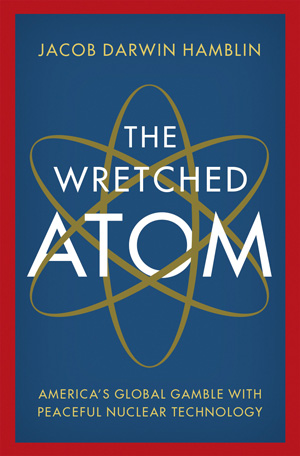
The Wretched Atom is a global history of so-called peaceful nuclear technologies. It asks provocative questions about how we frame these as an escape from environmental pressures and as a path to accelerated economic growth. I describe it as “America’s gamble” in the subtitle because, in the 1950s, the United States offered to share civilian technologies with the rest of the world. It did so before anyone in the US had even built a civilian nuclear power plant, and before having an idea of what “peaceful” nuclear programs might look like. Lots of countries took the US up on that promise, with unexpected consequences!
Here’s a disclaimer, though. It’s a global history but it focuses mostly on areas that today are called the Global South. American propaganda targeted the developing world, where people were threatened by famine, drought, and disease. These countries were comprised largely of non-white peoples, many of them former colonies or recently under military occupation (such as Japan). So I’m very interested in the perceived racial dimensions of nuclear technology. I explore the embrace of nuclear technology in large and populous former colonies such as India and Brazil, but also smaller ones such as Ghana and other African states. I focus a lot on the period from decolonization, in the 1950s and 1960s, to the emergence of the Middle East and South Asia as flashpoints of concern about nuclear weapons, in the 1970s and 1980s.
What do I mean by nuclear technology? That part is complicated. Perhaps surprisingly, for countries of the developing world, it often did not mean nuclear power plants. The US and other nuclear weapons states promised to cure diseases, produce new foods, and make deserts bloom. In practice, it meant launching programs on mutation plant breeding, food and grain irradiation, water treatment plants, and more. In other words, these were technologies that utilized materials from reactors, and were not reactors themselves.
It turns out, though, that most countries wanted electric power plants, not just agricultural applications. That became a bone of contention, especially as critics pointed out that it seemed like a familiar colonial relationship, with “white” atomic energy aimed at electricity generation and “colored” atomic energy aimed at agriculture and medicine.
One of the themes of The Wretched Atom is the “cornucopian” promise of atomic energy. This is a term used a lot in the 1970s by those who wanted to harness technology to increase food production, mitigate environmental problems, and cure diseases. It hearkens back to an image from ancient Greece, the horn of plenty. What I’m trying to show is how the cornucopian promise started out as a powerful propaganda tool but then was adopted by many different political actors around the world for a variety of purposes. Sometimes that purpose was to achieve energy independence. Sometimes it was to modernize the economy. Sometimes it was to hide bomb programs.
A lot of people assume it’s an antinuclear book. When you put “wretched” in the title, I guess I shouldn’t be surprised that it’s interpreted that way. I’ve even gotten some hate email from advocates of nuclear power who have assumed (without reading it) that this book is intended as a take-down. But the “wretched” in the title refers to a central tension of the book, namely the significance of promoting nuclear technologies in the so-called developing world during the era of decolonization. We usually think of nuclear technology as a Cold War story (and it is!) but we sometimes neglect to see it through the lens of colonialism, control of the earth’s natural resources, and narratives about modernization.
The title is inspired by Frantz Fanon’s 1961 book Les Damnés de la Terre, published later in English as the Wretched of the Earth. Fanon pointed out that the promise of rapid development often led to new kinds of dependence. Because I’d encountered some documents at the Food and Agriculture Organization voicing the same kinds of concerns about nuclear technology, I wanted to use that framing for the book as a whole.
I’ve tried to position The Wretched Atom as a global history of one of the most misunderstood political weapons of the twentieth century. It was adopted by President Truman and every US president afterward to exert leverage over other nations’ weapons programs, to corner world markets of uranium and thorium, and to secure petroleum supplies. Other countries embraced it too, for their own reasons. Atomic promises were embedded in Japan’s postwar recovery, Ghana’s pan-Africanism, Israel’s quest for survival, Pakistan’s brinksmanship with India, and Iran’s pursuit of nuclear independence. I see the book as an invitation to confront the role of civilian nuclear technology as an instrument of power, and to perceive the historical legacy of racism and colonialism even in today’s nuclear order.
As a researcher, what I really enjoy is working in archives, and ferreting out new material that hasn’t previously been the focus in existing work. For this book I tried to get away from simply using US documents (although there are plenty of those!) and instead to shift the focus to a more global perspective, using the archives of international organizations. So there’s a great deal of source material here that hasn’t appeared in print, including controversies at the International Atomic Energy Agency (Vienna), Food and Agriculture Organization (Rome), and World Health Organization (Geneva). In fact the idea for the book came while doing archival research in Rome, where I found a mountain of documents related to a disgruntled employee who accused his bosses of corruption. How could I ignore those documents?
I have a hard time deciding what is the best entry point for this book. Some people will be fascinated by the story about the CIA collaborating with a Japanese politician to propagandize the peaceful atom in Japan in the 1950s. The turnaround in public opinion about nuclear technology in Japan was truly astonishing, and it’s an important part of the book. It turns out that Japanese newspapers were working hard to present American viewpoints, in return for political favors. The material I used for that chapter came from a surprising source: declassified US documents related to Nazi and Japanese war criminals. These were available because of the Nazi War Crimes and Japanese Imperial Government Disclosure Acts, and when I perused them I did not expect to find material on the 1950s. But one particular public figure had been imprisoned by the Americans after the war, so all of his files became available under the law, even during the postwar period when he worked to aid the CIA.
Another entry point might be the controversy surrounding the International Atomic Energy Agency, which most people today know for the “inspectors” who look for clandestine bomb programs. The agency existed in the 1950s and 1960s for a different reason: to promote peaceful nuclear technology. Its major backers were the nuclear weapons states who needed the agency to prop up their claims of developing peaceful technology. So the IAEA’s leaders were always looking for success stories. I discovered a great deal of evidence of quashing of dissent within the agency, and one embattled employee accused the agency of corruption and falsification of evidence. The story is intriguing, and it opens up lots of serious questions about the role of that international agency around the world.
Probably the most unexpected angle, though, relates to petroleum. I start the book with an anecdote about Iran’s nuclear program, and its origins amidst the 1970s oil crisis. One reason the United States encouraged that program, along with other big-ticket items taking years to come to fruition, was to create bonds of dependence with Iran. Secretary of State Henry Kissinger was very specific about needing to give Middle East countries bills to pay so they couldn’t stop selling their oil. Convincing Iran to invest heavily in nuclear reactors seemed like the answer, back in the 1970s. We tend to treat oil and nuclear as separate stories, but the different kinds of energy are linked in surprising ways.
The rhetoric I write about in this book still appears in public discourse today. The promise of nuclear cornucopia is alive and well, especially in regard to climate change. Some would encourage us to believe that with a little bit of faith, nuclear technologies will pull us out of the mess we are in. We can rebuild nature, find a future of abundance, and outrun environmental pressures—so the argument goes.
The goal of the book isn’t to extinguish such hopes. I’d rather challenge the reader to see them as familiar arguments that have been deployed routinely over the past seven decades, not simply by the nuclear industry, but by governments. We often lose sight of how important such arguments are for governments who use the cornucopian promise of atomic energy to achieve strategic goals.
While we debate whether nuclear reactors are capable of mitigating climate change, we should not lose sight of how and why nuclear technologies continue to be endorsed by governments around the world. Just as the United States has used the cornucopian promise of the atom to protect is nuclear weapons program and its nonproliferation goals, so too have countries such as Japan, France, and Sweden because of their deep commitments to nuclear power in the pursuit of energy security. And so too did countries such as Israel, India, and other states that have longstanding multipurpose nuclear programs. And it shouldn’t surprise us that every emergent nuclear weapons state has deployed the rhetoric of lifting themselves out of poverty, reshaping nature, and providing abundant energy.
Despite such contemporary lessons, I think the value of the book is primarily as a history—not as a weapon to be wielded in debates about nuclear power. The Wretched Atom reveals like no previous book the extraordinary range of American propaganda in favor of civilian atomic energy. It traces the atom’s ever-increasing importance in the exercise of American power, from Harry Truman to Ronald Reagan. It unveils the acrimonious controversies about convincing poor countries to invest in atomic energy to improve agriculture and prevent disease. It also reveals how deeply entrenched the idea of peaceful atomic energy is in global politics, and how difficult it would be for any country—especially the United States—to give it up.


Jacob Darwin Hamblin is Professor of History at Oregon State University. Aside from The Wretched Atom, he is also the author of Arming Mother Nature: The Birth of Catastrophic Environmentalism (Oxford, 2013), Poison in the Well: Radioactive Waste in the Oceans at the Dawn of the Nuclear Age (Rutgers, 2008), and Oceanographers and the Cold War (Washington, 2005).